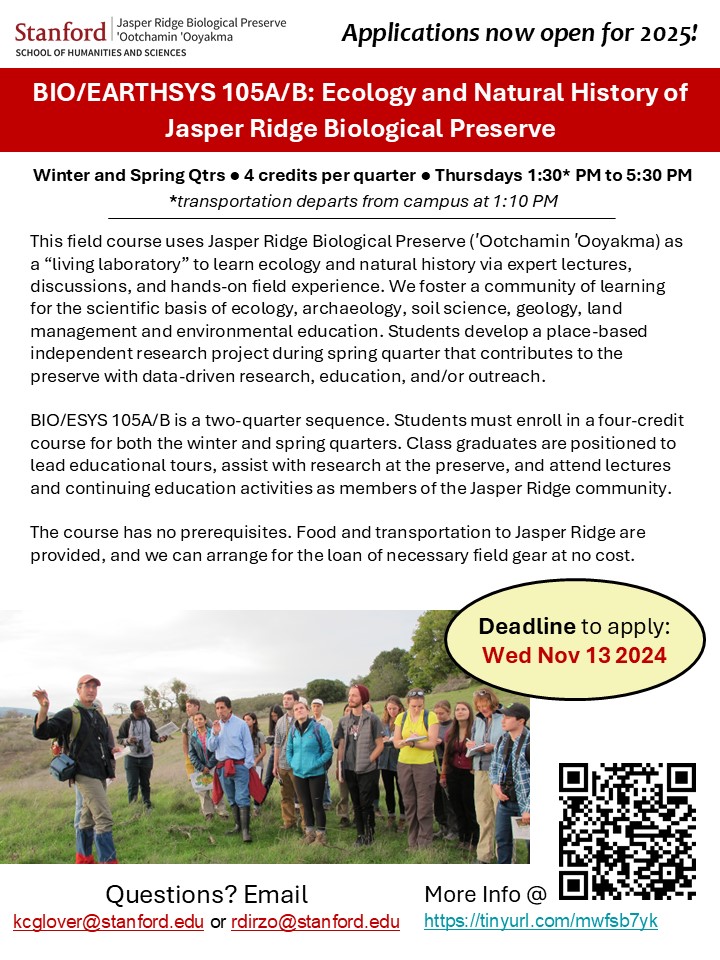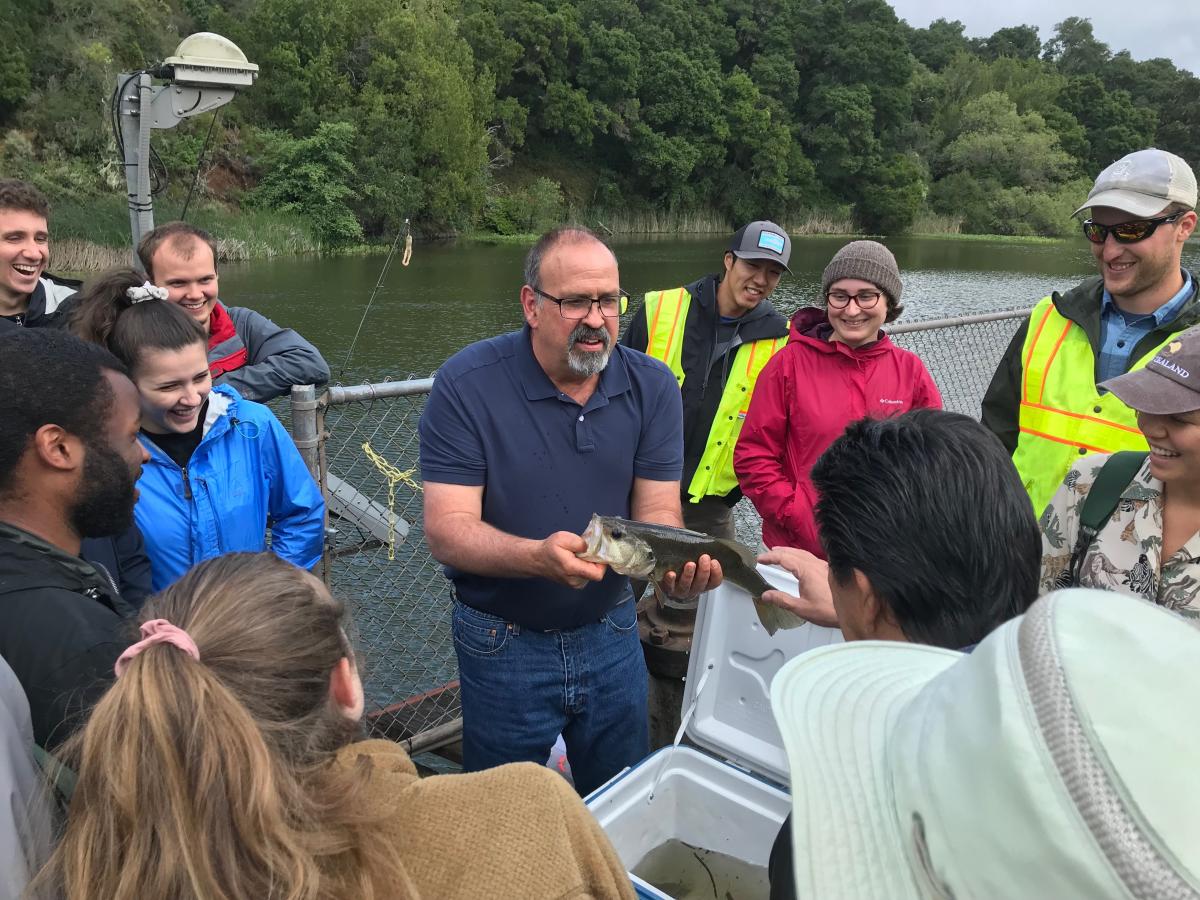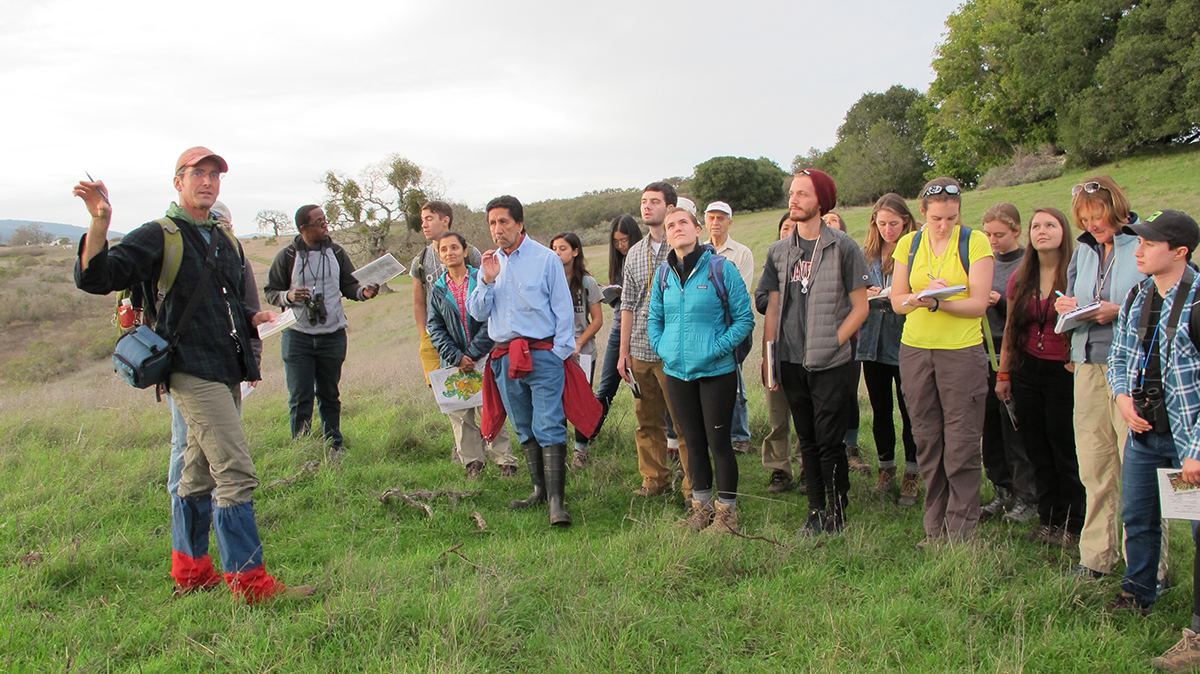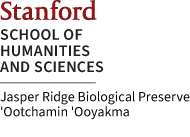BIO/EARTHSYS 105A/B: Ecology and Natural History of Jasper Ridge Biological Preserve
OVERVIEW
“Ecology and Natural History of Jasper Ridge Biological Preserve” (BIO/EARTHSYS 105A/B) is a multidisciplinary field course conducted at Jasper Ridge Biological Preserve (‘Ootchamin ‘Ooyakma) during the winter and spring quarters. The course is designed to use the preserve as a “living laboratory” to learn ecology and natural history via expert lectures, discussions, and hands-on field experiences. During the spring quarter, students develop a place-based independent research project that contributes to the preserve with data-driven research, education, and/or outreach.
Stanford students and members of the local community can apply to take the course. Graduates of the course become affiliates of the Jasper Ridge community. These affiliates lead our educational tours for visiting classes and the public as docents. They can also attend our continuing education programs and lecture series, participate in ongoing research at the preserve, and volunteer towards our ongoing stewardship.
HISTORY OF THE COURSE
In 1975, Jasper Ridge began developing community education programs that would enhance educational opportunities for both the university and the community. The initial focus was to engage members of the community and train them to be Jasper Ridge docents, with a willingness to then devote their time and expertise to students and the public via educational tours. The first Stanford students were incorporated into the docent program in 1977. The curriculum has evolved over time to become the current version of BIO/ESYS 105A/B. It is now an upper division course on ecology and natural history, and practicing data-driven science alongside training its participants to be JRBP docents.
THE ROLE OF DOCENTS IN THE JASPER RIDGE COMMUNITY
Upon completion of the course, students will be able to serve as Jasper Ridge docents. Docents represent the preserve as guides to the ecosystems and work done at the preserve,, and provide interpretive walks to visitors, support field education opportunities for visiting students, and increase community awareness of the preserve. In this way, Jasper Ridge docents are uniquely positioned to provide field -based education and are trained to "teach on the trail" with meaningful curricula to serve a very broad community.
Graduates of the course are considered Jasper Ridge affiliates and are welcome to attend our continuing education activities such as evening lectures and field classes. Jasper Ridge affiliates have opportunities to work with researchers and educators, and some projects at the preserve are managed largely by docent-led teams. For example, members of the Jasper Ridge community have conducted regular bird surveys and produced invaluable bird lists and databases for many years. JRBP affiliates efforts have also contributed to the teaching and outreach programs, the native plant collection in the Oakmead Herbarium, the geology display, and many other research and education projects.
The benefits of becoming a Jasper Ridge affiliate are many, including:
- access to Jasper Ridge Biological Preserve.
- opportunities to be an active member of the JRBP community.
- continue as a life-long learner in a world-renowned research and educational preserve.
- working personally in environmental education, ecology, and other rewarding research.
The course splendidly aligns with the Jasper Ridge community on providing opportunities for inquiry-based education in ecology and natural history, and incorporating both formal and informal educational methods in their practice. Instructors and students reflect this commitment in their own teaching and learning, and serve as a bridge to the volunteer base of the preserve.
COURSE FORMAT AND REQUIREMENTS
BIO/ESYS 105A/B consists of two courses (each 4 credits), offered during winter (A) and spring (B) quarters that must be taken in sequence in the same year. The course format includes in-person classroom and field sessions on Thursday afternoons from 1:00 to 5:30 PM. Course content spans a variety of disciplines related to ecology and natural history, including botany and zoology, geology, soil science, archaeology, food webs, among others.The different sessions are covered weekly with a lecture from expert Stanford faculty followed by hands-on fieldwork on the preserve.
The catalog description is available here. The class is open to Stanford students and a few members of the local community through an application process. In addition to Stanford undergraduates, we welcome applications from students in graduate, post-baccalaureate, and professional programs at Stanford. If you are concerned about the 4-credit enrollment with your graduate program requirements, please reach out to instructors to discuss your options.
Stanford's long-standing policy on course credits is published in the Stanford Bulletin, and states that every unit for which credit is given is understood to represent approximately three hours of actual work per week for the average student. This policy is in compliance with federal regulations. For more information, visit the Stanford Registrar's Office.
Participants are expected to commit to be present every week, as these experiential sessions cannot be replaced with make-up activities if missed. Timely arrangements must be made with the teaching team in the case of illness or other unavoidable circumstances. Participants are also expected to develop an independent project during the spring quarter that contributes to preserve’s scientific research and education mission with data-driven research, and/or education and outreach topics. This will require the student to arrange at least two field work sessions for their independent sessions, and give a project presentation and report as final assignments for the spring quarter.
We provide transportation to and from Stanford main campus to Jasper Ridge on Thursday afternoons. Food and snacks are provided at the start of the session. Recommended field gear includes closed-toe hiking boots or shoes, a backpack, water bottle, waterproof jacket, long field pants, sun hat, and sunglasses. This gear can be available for loan at no cost. For your project field sessions, we first provide emergency and safety training following our “Safe Field Practices and Culture of Respect.” The teaching team can help arrange transportation, carpools, and field support as needed.
Working in California’s ecosystems comes with inherent risks from poison oak, ticks, rugged trails, thick brush, and rattlesnakes. You will be advised on how to best mitigate these risks to keep yourself and visitors safe. More information is available at our Health & Safety Information webpage.
COMMUNITY OF LEARNING AND RESPECT
We support a diverse, multidisciplinary, and intergenerational learning community in BIO/ESYS 105A/B. We are committed to a community-based learning environment in which diversity, inclusion and belonging are central. One of our goals is to build comfort and confidence in students to work “in the field” and implement the scientific method, especially for new practitioners. Thus, it is crucial all participants foster a community of learning and respect, and we ask that all participants commit to be thoughtful in their interactions. We strive for everyone to feel comfortable in sharing ideas, asking questions, listening actively, and collaborating effectively.
_________________________________________________________________________________________

We follow Stanford's academic calendar
Important 2024 dates to apply for 2025 BIO/ESYS 105:
October 30 2024 - Applications will open
Application deadline - Wed Nov 13 by 11:59 PM (Pacific Time)
Nov 2024 - Review of applications
late Nov - early Dec 2024 - Community member interviews, cohort confirmed
Important 2025 Winter Quarter dates:
Thursday Jan 9, 2025 - First day of 105 classes for Winter Quarter
Thursday March 13, 2025 - Last day of 105 classes for Winter Quarter
March 17 - 21, 2025 - Winter Quarter Finals Week
March 22 - 29, 2025 - Spring Break
Important 2025 Spring Quarter dates:
Thursday April 3, 2025 - First day of 105 classes for Spring Quarter
Thursday June 5, 2025 - Last day of 105 classes and graduation ceremony!
June 6 - 11, 2025 - Spring Quarter Finals week
APPLICATIONS FOR 2025:
Please read the details about the course above carefully, as well as the first page of information on the application. We are grateful to our partners with the Inclusive Field Education Community of Practice for their help in substantive updates and revisions to our material supporting the application process. The first page of the application includes the criteria we are looking for in strong applications. This page also includes a few links to pages on our website. We recommend that you familiarize yourself with this information as you work on your application answers.
Application for Community Members - Click to download
Application for Stanford students (must enroll for 4 credits during both Winter and Spring Quarters) - Click to download
We maintain a directory of all BIO/ESYS 105 Ecology and Natural History of Jasper Ridge Biological Preserve alumni, and do periodic updates with new records and changes. If you or someone you know has taken the class in the past and can contribute updates, please contact Katie Glover (kcglover@stanford.edu)


For more information about BIO/ESYS 105, please contact:
Katherine Glover, Ph.D.
Associate Director for Environmental Education
Jasper Ridge Biological Preserve
kcglover@stanford.edu
Work Cell: (650) 374-6472



